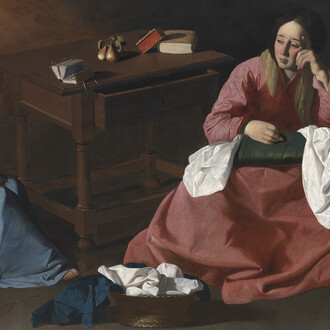Across geographical and cultural boundaries, textile production in its myriad forms is one of the earliest human technologies, with woven and dyed fibred dating back to prehistoric times. The art of designing textiles has therefore remained a central medium for both utility and creative expression throughout human history.
New Art Centre’s exhibition Common Thread brings together a group of artists each of whose work focuses on the history of textile technology and design, and their shifting values for people across place and time. Exploring the ways in which certain textile producing technologies are still in effect while others are being challenged, the works in this exhibition reflect on the place of textiles both in art and in contemporary society.
Like weaving, in which material strength is built through an interlocking structure, the fragility in the work of Jodie Carey (b. UK) is attenuated when the different parts of her tactile sculptures come together. Originally trained in textiles, her large-scale, spatial interventions and installations attend to the texture and ephemerality of her chosen materials and the site within which they are formally arranged.
Mark Corfield-Moore (b. Thailand), uses weaving techniques to create contemporary tapestries, his works incorporating the representation of historical events or specific characters that are abstracted to depict more universal narratives. His influences include the histories of Amalfi Coast parasols which carry the art of ‘studied carelessness’ practised by 14th-century Italian courtiers, and the life of Kitty Fisher, an 18th century British courtesan who, among other notable activities, would eat ‘money sandwiches’.
The textiles used in Ayan Farah’s (b. UAE) paintings are weathered, stained or worked upon with such substances as ash, salt, vinegar and terracotta. Exploring contrasting man-made and natural influences, her works are often formed through their exposure to sun and wind and then stitched together as tapestries or draped onto wooden stretchers. The ultimate abstractions become material indexes to the landscape in which they are formed.
In their explorations of new languages of craft, Forest and Found’s Max Bainbridge (b. UK) and Abigail Booth (b. UK) use traditional techniques of woodworking, patchwork and quilting to create artworks from found and reclaimed material. With felled timber from the grounds of the New Art Centre, Bainbridge has carved bespoke sculptural vessels conceived for the Design House, complimented by Booth’s paintings that incorporate wood shavings from Bainbridge’s work.
Sculptor David Murphy (b. UK) cites textile processes and a textile 'language' as an integral part of his practice. Murphy has developed the motif of the ‘magnified thread’, examining how the layering and intertwining of materials spans all mediums. Seen clearly in his sculptural works, where steel wires are bent and woven through rings to form rigid tubes. Using archival paper and laser-cutting technology, Isobel Napier (b. UK) designs and creates intricately constructed paper sculptures that resemble woven fabric. Through her carefully honed processes, paper is transformed into an altogether different medium, one that is extremely malleable, with her hanging works becoming soft and flowing. Napier then uses the analogue process of contact printing to record photograms of these sculptures, mirroring their spectral ephemerality.
Working from her studio in London, Amy Revier (b. USA) creates individual textiles and garments on a traditional wooden floor loom. With her carefully selected, hand-dyed yarns from Scotland and Japan, she spends weeks on each piece, allowing the final shape of each garment to develop intuitively as she weaves. Drawing from a wide range of references across textile history and literature, Revier’s approach reveals her on-going interest in the relationship between sculpture and textiles, and her final offerings are as much about the process of weaving as the garment itself.
Having trained as a textile designer, Sophie Rowley’s (b. NZ) practice investigates the physical properties of her chosen materials. Through research and experimentation, Rowley methodically deconstructs the often invisible processes of making, revealing unexpected material results. Her recent work focuses on Indian hand-weaving techniques, which are unpicked and frayed to leave layered and intricate wall-based textiles. Gray M.C.A. (UK) is dedicated to showing the range and development of fashion illustration and artist textiles over the past century. The selection from Gray M.C.A’s collection in Common Thread includes works by William Scott RA (1913 - 1989) and Ben Nicholson (1894 – 1982).
Referring to the ancient, pre-Colombian use of textiles as a form of language, Katharine Swailes’ (b. UK) abstract works consider the tactility of the cotton and linen fibres of which they are constituted. Appearing deceptively minimal in their construction, Swailes’ woven pieces cohere meditatively through their careful balance of tone, colour, pattern and volume. Through this range of approaches, the artists in Common Thread each in their own way explore the link between the history of textiles and art. Together the works on display showcase the ways in which the development of material experimentation has allowed contemporary artists to expand on and learn from traditional textile production in its diversity of forms. The exhibition is therefore a celebration of the return to early methods of artistic creation by both contemporary artists and textile designers alike.












